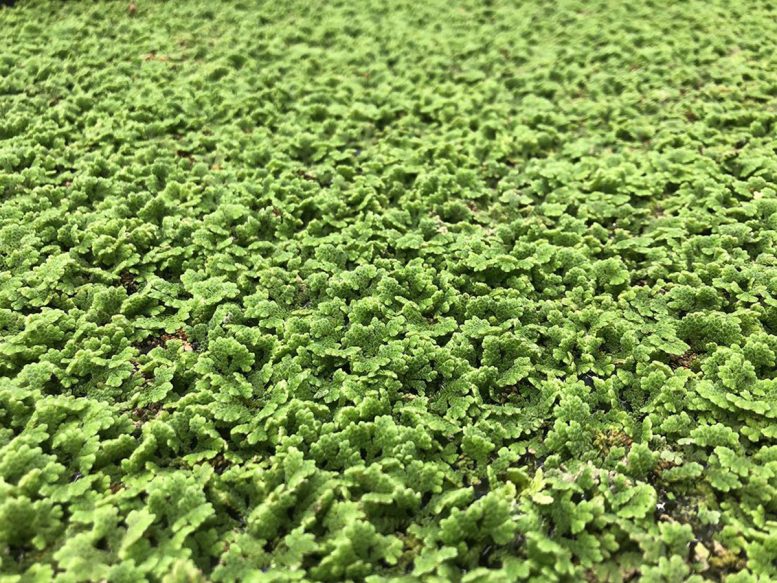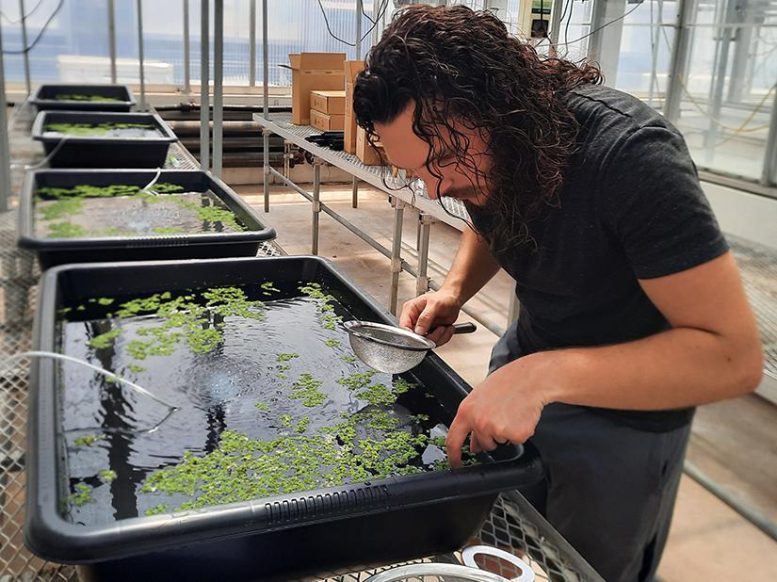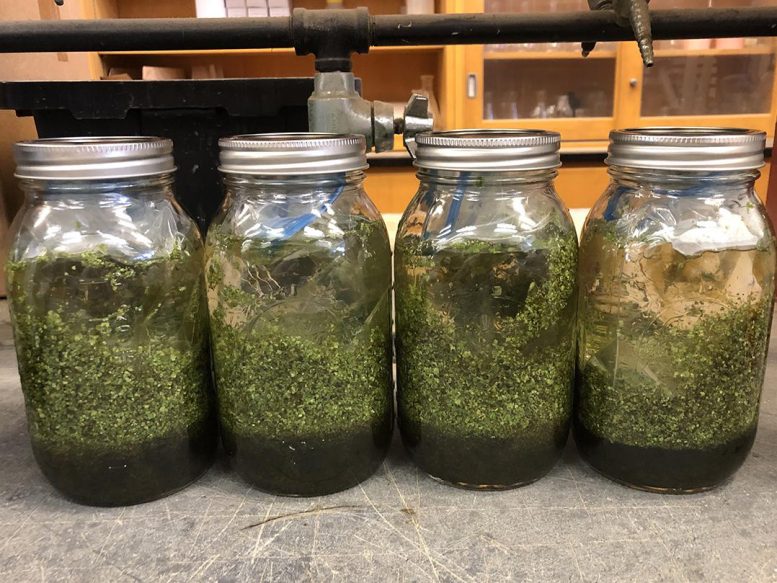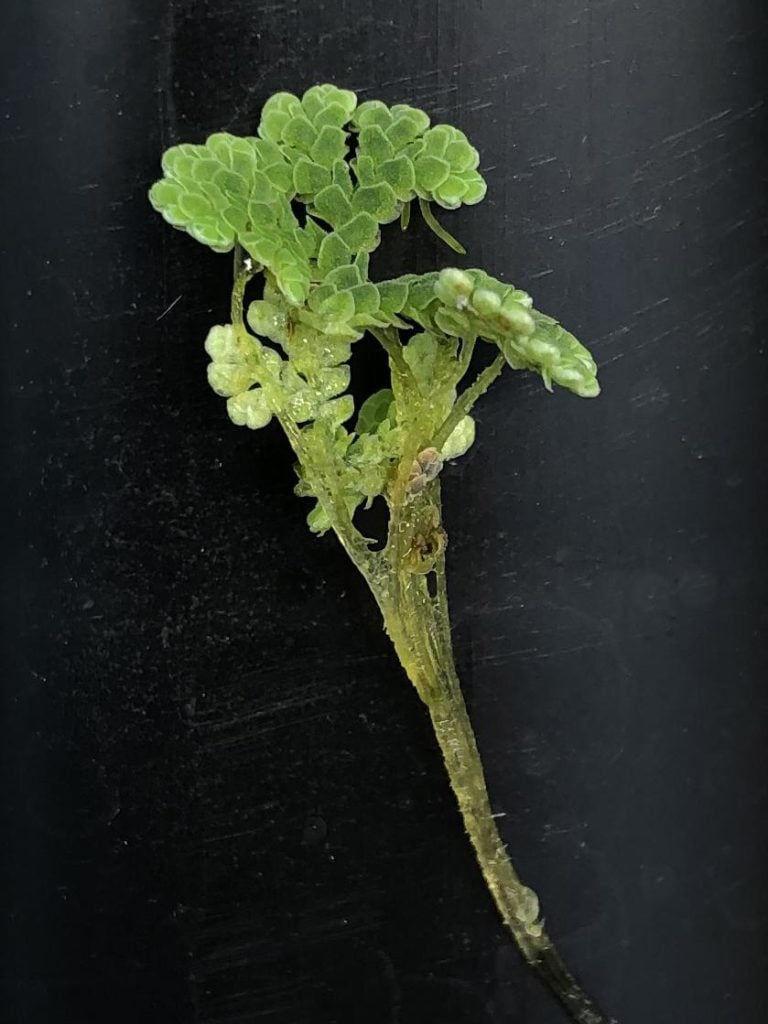
Native to the eastern U.S., Carolina azolla holds excellent potential for use as a fast-growing, short-season crop that requires minimal inputs, upkeep, and processing, according to Penn State researchers. The plant — sometimes referred to as mosquito fern, fairy moss, and water fern — could be used to increase the food supply. Credit: Penn State
The rapidly expanding aquatic fern possesses the nutritional profile necessary to act as a crucial food source in post-disaster scenarios and could be relevant now.
An often-overlooked water plant that can double its biomass in two days, capture nitrogen from the air — making it a valuable green fertilizer — and be fed to poultry and livestock could serve as life-saving food for humans in the event of a catastrophe or disaster, a new study led by Penn State researchers suggests.
Native to the eastern U.S., the plant, azolla caroliniana Willd — commonly known as Carolina azolla — also could ease food insecurity in the near future, according to findings recently published in Food Science & Nutrition. The researchers found that the Carolina strain of azolla is more digestible and nutritious for humans than azolla varieties that grow in the wild and also are cultivated in Asia and Africa for livestock feed.
Research Findings and Cooking Methods
The study, which was led by Daniel Winstead, a research assistant in the labs of Michael Jacobson, professor of ecosystem science and management, and Francesco Di Gioia, assistant professor of vegetable crop science, is part of a larger interdisciplinary research project called Food Resilience in the Face of Catastrophic Global Events conducted in the College of Agricultural Sciences.

The study was led by Daniel Winstead, pictured here, a research assistant in the labs of Michael Jacobson, professor of ecosystem science and management, and Francesco Di Gioia, assistant professor of vegetable crop science. It is part of a larger interdisciplinary research project called Food Resilience in the Face of Catastrophic Global Events, conducted in the College of Agricultural Sciences. Credit: Penn State
“Other species of azolla have been used across the world for several thousand years as a livestock feed and as ‘green manure’ to fertilize crops because of the plant’s ability to fix nitrogen,” Jacobson said. “The use of azolla for human consumption was thought to be limited by its high total polyphenolic content, which interferes with its digestibility. But this research demonstrates that the phenolic content of the Carolina strain is much lower, and cooking the plant diminishes it further.”
Polyphenols, which are naturally abundant compounds found in plants, at lower concentrations are beneficial to human health because of their antioxidant activity, however, high concentrations of polyphenols can limit nutrient absorption in the body and act as antinutritional factors, Jacobson explained. Gallic acid is a stable phenol and has become a standard measurement to determine phenol content in food.
The Nutritional Value and Cultivation Potential of Carolina Azolla
In the study, Carolina azolla — which has been described as having a crisp texture and a neutral taste — was grown in a greenhouse located at Penn State’s University Park campus. The researchers determined that Carolina azolla has a total phenolic content of about 4.26 grams, gallic acid equivalents per kilogram dry weight.
This measurement compares with fruits, Winstead pointed out, which generally are between 1.4 and 6.2; beans at 1.2 to 6.6; and nuts, ranging from 0.5 to 19. By comparison, he added, other species of azolla that grow in Asia and Africa are between 20 and 69 grams, gallic acid equivalents per kilogram dry weight — too high for humans to digest comfortably.

The researchers tested three cooking methods that multiple studies have shown can decrease polyphenolic content in foods, with the aim of reducing antinutritional factors potentially restricting consumption of azolla — boiling, pressure cooking, and natural fermentation, which is shown here. Credit: Penn State
The researchers tested three cooking methods — boiling, pressure cooking, and natural fermentation — that multiple studies have shown can decrease polyphenolic content in foods, with the aim of reducing antinutritional factors potentially restricting consumption of azolla by both humans and livestock. Tests showed total phenol content was reduced by 88%, 92%, and 62% with boiling, pressure cooking, and natural fermentation, respectively, compared to the raw plant.
Carolina azolla — sometimes referred to as mosquito fern, fairy moss, and water fern — holds excellent potential for use as a fast-growing, short-season crop that requires minimal inputs, upkeep, and processing, Winstead noted, adding that the plant could be used to increase the food supply.
“Our study highlights the nutritional value and moderate protein content of Carolina azolla and demonstrates that cooking methods easily and significantly reduce total phenolic content,” he said. “Azolla’s moderate protein and high mineral yields make this species desirable for cultivation.”
The easy, fast-growing nature of azolla cultivation makes it an ideal resource during disasters and catastrophes, as well as for regular use by smallholder farms and low-income areas, the researchers said. It is a multipurpose wild edible plant that holds great potential for economic, agricultural, nutritional, and resiliency benefits, but needs further development, they said.

The researchers found that the Carolina strain of azolla is more digestible and nutritious for humans than azolla varieties that grow in the wild and also are cultivated in Asia and Africa for livestock feed. Credit: Penn State
“Whether it be for a ‘quick-fix’ solution in catastrophe scenarios or long-term resilience plan, Carolina azolla has the potential to provide large amounts of protein and calories for people and livestock,” he said, noting that the plant has even been considered for inclusion in the U.S. space program. “If systems for azolla cultivation and preparation can be made more efficient, its indoor or outdoor cultivation after natural disasters could provide supplemental nutrient production that is climate resilient.”
Azolla’s Role in Sustainable Food Systems
This study links to other ongoing systematic reviews by the same Penn State researchers examining regional, resilient, drought-resistant food crops and increased agrobiodiversity in the face of disasters becoming more frequent and often resulting in food-system disruptions. For example, one paper published in Frontiers in Sustainable Food Systems, looks at the plethora of currently seldom-used wild edible plants of North America that once were used abundantly by Native Americans.
“Currently, we are doing reviews in African regions,” Jacobson said. “Hopefully, exposing the viability of the lesser-used plants can help society be more prepared to secure a resilient food system.”
Marjorie Jauregui, doctoral degree student in food science and international agriculture, contributed to this research.
Reference: “Nutritional properties of raw and cooked Azolla caroliniana Willd., an aquatic wild edible plant” by Daniel Winstead, Francesco Di Gioia, Marjorie Jauregui and Michael Jacobson, 10 January 2024, Food Science & Nutrition.
DOI: 10.1002/fsn3.3904
This research was funded by the Food Resilience in the Face of Catastrophic Global Events grant funded by Open Philanthropy and was supported by the U.S. Department of Agriculture’s National Institute of Food and Agriculture.









🫐♥️
What an interesting plant….however is an aquatic plant actually considered drought resistant?
Interestingly an aquatic plant in Africa where community freshwater systems are limited,
Is actually pretty insulting to the African peoples who have traditionally used this food for livestock….what an insult to those people. Whom or What organization is responsible for this travesty?
That depends on who wins the battle for the future.
If it’s won by Klaus Schwab, we all eat ze bugz.
If it’s won by Bill Gates, we all eat tumbleweed.
I am not sure that the comment above is correct in it’s assessment. Azolla is a plant that spreads quickly to cover open water surface and as such probably reduces evaporation. In my own experience, it significantly reduces (potentially lethal) temperatures in shallow areas, by preventing solar heating. It may be that the evaporation of natural shallow pans of water can be slowed between periods of rain by azolla. It’s leathery leaf does prevent dessication from occurring as quickly as many other aquatic plants. It also prevents pond and canal clogging aquatic weed growth below the surface of the water. Certainly worth further study. Unintended consequences must always be thoroughly explored, before any actions should even be contemplated.
But this is an interesting bit of research.
Mmm Soylent green….
Olive oil can have (poly)phenols up to 1 g / kg. Cocoa powder closely resembles the 4.25 mg/kg zolla quantity at 3.448 mg/kg.
Perhaps zolla could be used for its oil. Mixing it with another cooking oil in equal quantity would necessarily reduce its phenol content by 50%.
https://www.nutritionadvance.com/nutrition/top-food-sources-polyphenols/
I see the dry weight of gallic acid extraction is not more than olive oil at 50 – 400 mg / kg.
https://pubmed.ncbi.nlm.nih.gov/23070730/#:~:text=The%20total%20reducing%20capacity%20%28total%20phenolics%29%20of%20olive,40%20to%20530%20mg%20gallic%20acid%20equivalents%2Fkg%20oil.
Can we all stop softening the meanings of words?
“Food insecurity” is “hunger”.